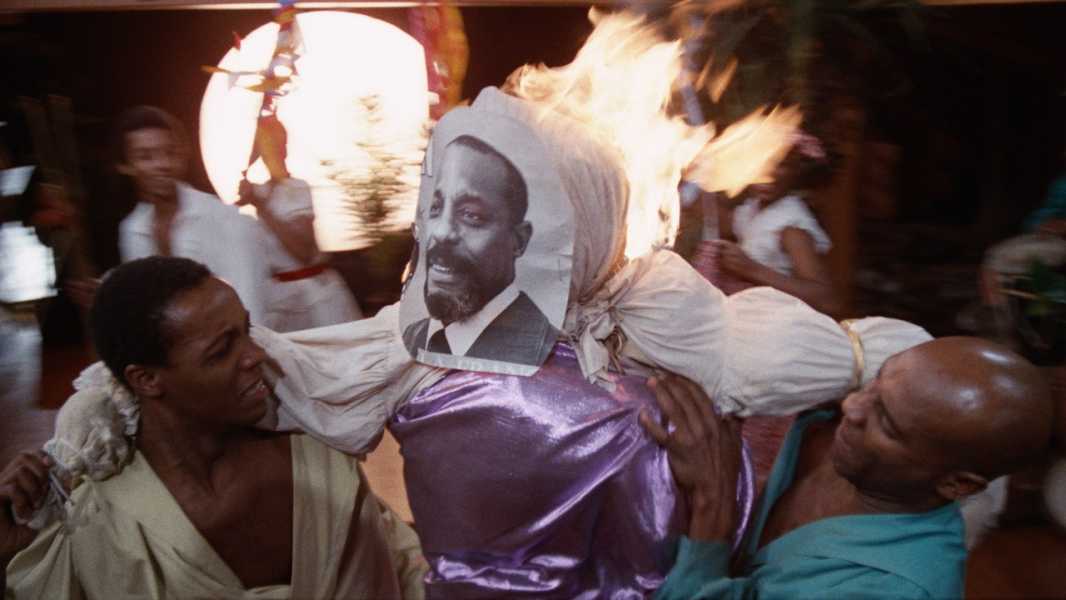
Save this storySave this storySave this storySave this story
This upcoming Friday, when two simultaneous New York revivals of Med Hondo’s films get under way, many viewers are going to find their cinematic map expanding. Film Forum will be screening a new restoration of Hondo’s large-scale, big-budget 1979 musical “West Indies: The Fugitive Slaves of Liberty,” while Anthology Film Archives presents a retrospective of most of his other features—from the first, “Soleil Ô” (1970), to the last, “Fatima, the Algerian Woman of Dakar” (2004)— along with a number of his short films. Hondo was born in 1935, to a Mauritanian mother and a Senegalese father. He was raised in Mauritania and, after some years in Morocco, moved to France in the late nineteen-fifties, eventually finding work as an actor and director. Hondo is both an African filmmaker and a French one. He films aspects of French life that remained largely hidden in the works of white directors there: his principal subject was French colonialism, as it has affected Africans for centuries and as it continues to affect and afflict the lives of Africans, including those who migrate to France.
Hondo, who died in 2019, made his films internationally—in France, Senegal, Mali, Burkina Faso, and Tunisia—and he extended his attention to the African diaspora, whether in France or in French territories elsewhere, such as in the Caribbean. Hondo’s work shows French cinema to be African cinema because of the historical connection between France and Africa. From this central preoccupation, Hondo devises a distinctive and singular aesthetic, sharply personal yet historically informed. He does not simply reveal aspects of history and society on film that were largely hidden from the cinema; he subjects them to a cinematic transformation that reveals the inability of previous forms and styles to express them.
Hondo’s first feature, “Soleil Ô,” is, in effect, a sketch tragedy, an unfolding of cruelty and injustice by way of fragmentary episodes and skits. It revolves around an unnamed African migrant to Paris (played by Robert Liensol) who faces brazen racism and craven exploitation in his efforts to find work and housing. But this story is only a very loose framework for Hondo’s vision—at once theatrically symbolic and reportorially specific—of ingrained racial prejudice in France, both in private relationships and public institutions. The movie starts with a playlet in which a white French priest baptizes a group of African men, who renounce their various native languages and are given French names; the men then march in procession, bearing long crosses, which, under military orders, they turn upside down and wield as swords in order to fight one another to the death, for the entertainment of a white French officer.
This prologue is a kind of burlesque allegory of injustices that much of the rest of the film will examine with harrowing realism. The traveller arrives in France full of enthusiasm—in voice-over, he claims to be “coming home” there, having so long imbibed French culture—but he soon finds that he’s hated for the color of his skin, treated as part of an invading horde of savages, feared by many and fetishized by others. Hondo employs a panoply of devices—drawings and animation, still photos and puppets, direct addresses to the camera and interior monologues, dream sequences and documentary footage—as he shows how racist hostility drives the protagonist to a psychological crisis of identity that is, effectively, a geopolitical nervous breakdown.
The audacious form of “Soleil Ô” reflected the times. Hondo was working in a Paris saturated with the influence of the French New Wave. (Indeed, he made his film début in Jean-Luc Godard’s 1966 film “Masculine Feminine,” acting out a scene from Amiri Baraka’s “Dutchman,” which Godard had just seen him perform onstage.) The fragmented and varied form opens the movie up beyond the confines of its realistic action, letting in a kaleidoscopic sense of historical and sociological context, ideological ambiance, and inner experience. Hondo reaches far beyond the troubles of an individual person, keeping in constant view the vast system of colonialism and its menacing, zombielike afterlife in the era of African independence.
One of the most striking parts of “Soleil Ô” is an extended section set in the embassy of an unnamed African country, which garishly dramatizes the predatory corruption of the country’s new President, who defends his coup in the name of democracy. This sequence establishes a key theme of Hondo’s career: the ease with which colonial powers divide and conquer those whom they oppress, creating incentives that lead Black Africans (or members of the diaspora) to play an active role in the subjugation of their own peoples. That idea is central to Hondo’s next dramatic feature, “West Indies,” from 1979.
A surprising omission from the credits of “Soleil Ô” is a mention of any production company; that’s because Hondo, like many white New Wave directors, made the movie as an independent. He had no company, just contributors, and he put his own earnings as an actor into the project. The movie took him a year to shoot, working when he “could afford to buy a reel or two of film” and depending on when his actor friends were available. The movie played in a small Paris theatre in 1973, as he told a journalist from Le Monde: “Nobody made a cent, and I had to continue my work all alone, outside the norms of the commercial cinema, like a homeless person of celluloid.”
For the next few years, while trying to make his next dramatic feature, Hondo worked on documentary and documentary-hybrid films. When he finally made "West Indies," it was on a far larger economic scale than that of "Soleil Ô." He secured a grant from France and commercial investments from Algerian television and from Mauritanian and Senegalese companies. He had a budget of about one and a half million dollars, which was, at the time, the highest ever for an African film. Shooting took place in France, in a large empty factory workspace where the acclaimed set designer Jacques Saulnier, a longtime collaborator with Alain Resnais and Claude Chabrol, built an enormous set in the form of an old wooden ship that becomes almost a character in its own right.
The action, adapted from a play by the Martinique-born writer Daniel Boukman, takes place on a Caribbean island that’s under French colonial rule. Its white governors prop up one local Black politician—a powerless puppet who maintains his position through the energetic stuffing of ballot boxes. The white politicians implement a scheme to encourage locals to immigrate to Paris, in order to rid the island of its poor and provide France with cheap and docile labor, and the Black politician backs them up. The island’s Black bourgeoisie vigorously collaborates, too, touting the enticements of the metropolis’s cultural attractions and material luxuries, and offering high-flown paeans to liberty, fraternity, and equality.
As I mentioned earlier, “West Indies,” for all its incisive sociopolitical critique, is a musical, filled with singing and dancing, and staged with flamboyant, camera-addressing artifice. When islanders are queuing up to board an Air France flight to Paris (and performing a song of farewell to sea and sun, poverty and unemployment, fear and anger), Hondo’s camera watches them file off into the background as another group of Black travellers emerge in the foreground—enslaved Africans, chained and terrorized, being forced onto the ship that the mighty set represents. Here, Hondo begins a large-scale recapitulation, in a handful of scenes, of the grimly infuriating history of French colonialism from the seventeenth century to the twentieth, and of a reliance on slave labor that lasted in the Caribbean colonies until the mid-nineteenth century.
Ideologues and power-mongers of many sorts, from brazen Black profiteers in Paris to frivolous white do-gooders, fill the frame with their declamations. Musical numbers with bitterly ironic lyrics parrot transparently empty slogans that conveniently subordinate Black liberation to white causes. (Pointedly, these include communism and the French labor movement, with their confidence in a class-based reading of the course of history.) When the island does achieve independence, the result proves to be a sham. France, paying lip service to ideals of fraternal alliance, will perpetuate its political and economic exploitation. Still, the island’s poor people express their skepticism and their indignation in the joyful and determined energy of music and dance, as they prepare their rebellion in the cause of true independence.
The two distinguishing aspects of Hondo’s work are heterogeneity and rhetoric. Most of his dramatic features are put together from disparate pieces—not merely, like most films, scenes held together by plot but collages of sequences touching on many stories and subjects and held together not by the power of ideas. This is true even of his later films that might seem more conventionally narrative, such as “Sarraounia” (1986), which depicts France’s late-nineteenth-century invasion of West Africa in a way that is both dramatically compelling and artistically distinctive.
The movie follows a resistance movement led by the warrior queen Sarraounia, a historical figure who fought against the French in 1899 in what is now Niger. Hondo introduces her as a child raised as the ward of an educated foster father, who teaches her about science, war, psychology, and ethics, and who encouraged her freethinking resistance to tradition and religion. Then, as an adult on the throne, she’s revered by her people both as a ruler and as a sorceress, and this fearsome reputation proves strategically important. The French Army commands large numbers of African troops who are uninhibited about torturing and killing other Africans but are terrified by what they’ve heard of Sarraounia. Meanwhile, members of a neighboring tribe are split about whether to join forces with the feared Sarraounia against the French or to stay on the sidelines and hope that the European interlopers will eliminate their powerful rival.
Hondo’s staging is clear and classical, with mighty formations of soldiers, skirmishes on horseback, terrifying acts of brutality, turbulent crowd scenes, and intimate dramas of debate, whispers of counsel, and hubristic rants. But his narrative sense—not just his editing but the dramatic conception from which it springs—is again collage-like, a cinematic mosaic that pulls together disparate fragments of action from widely scattered locations and holds them together with the virtual power of the titular protagonist. It’s notable that Sarraounia is not onscreen all that often. She dominates the movie the way she dominates the region—by the ambient force of reputation and authority, and, above all, by the principle of resistance that she represents.
Hondo’s next feature, “Black Light” (1994), is his slyest, bending the thriller genre to his vision. Based on a novel by the crime writer Didier Daeninckx, it follows a white Frenchman who is determined to expose the wrongful killing of a friend by police and goes to Mali in search of a witness to the crime who has just been deported. The story becomes an exposé of the French bureaucracy’s cruel treatment of the country’s resident Africans, the government’s endemic corruption, and the hidden authoritarian ruthlessness with which it maintains power.
Hondo’s final film, “Fatima, the Algerian Woman of Dakar,” is based on a true story and stands as his starkest drama about the collaborationist politics that divide African society. It begins, in the nineteen-fifties, during France’s notoriously brutal war against Algeria’s independence movement. Soldiers recruited from Senegal have been brought in to supplement the French troops, and, during a raid, a Senegalese soldier named Souleymane rapes a young Algerian Berber woman named Fatima. (Hondo emphasizes that the French and their allies treat rape as a regular and unexceptional policy of war.) Cut to the nineteen-sixties, in newly independent Algeria. Fatima has a young son, Abdelkader, who is Black, and as a result she is shunned in her village and her son is subjected to racist insults. She and her family move to the city, hoping to find a more open-minded environment. But they discover that, in those early post-revolutionary days, the government is focussing not on modernization and economic development but on the promotion of a narrowly dogmatic Islamist ideology.
Souleymane, it turns out, is devoutly religious, and, back home in Dakar, he is stricken with guilt for what he has done. He confesses his crime to his father, who orders him to seek redemption by finding the woman he raped and marrying her. Souleymane contemplates the journey with dread, expecting that, in Algeria, he’ll be the victim of violent reprisals. He goes, nonetheless, and, riding through the Algerian countryside, recalls with horror the brutalities he witnessed and took part in during the war. When he meets Fatima’s family, he is surprised to be treated humanely, even welcomed. He and Fatima indeed marry and move with their son to Dakar, where Fatima is lovingly embraced by Souleymane’s extended family. The unexpectedly happy turn of events is however shadowed by unchallenged customs of male supremacy and vanity that will force Fatima to choose a path of independence—and that ultimately leads to a powerfully symbolic display of essentially revolutionary violence.
“Fatima” is a passionately humane and intimate work, but Hondo, as ever, is also concerned with the deeper allegorical significance of his subject. Fatima’s story holds out the promise of reconciliation and alliance between North and sub-Saharan Africa, and the film offers a grandly metaphorical yet relentlessly revolutionary invocation of pan-African unity. In Hondo’s unsparing view, overcoming colonialism’s unresolved legacy is a challenge that demands almost superhuman courage and resolve, along with an uninhibited sense of spiritual freedom. ♦
Sourse: newyorker.com






